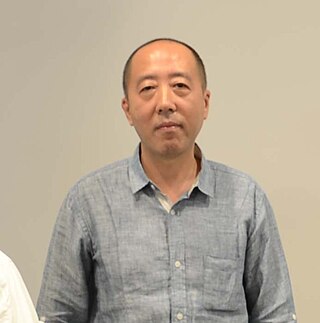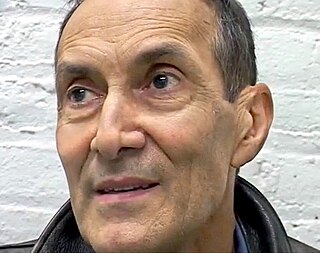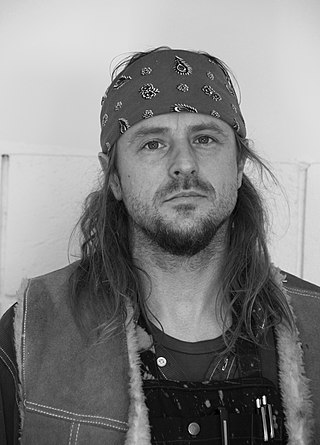
Marc Quinn is a British contemporary visual artist whose work includes sculpture, installation, and painting. Quinn explores "what it is to be human in the world today" through subjects including the body, genetics, identity, environment, and the media. His work has used materials that vary widely, from blood, bread and flowers, to marble and stainless steel. Quinn has been the subject of solo exhibitions at Sir John Soane's Museum, the Tate Gallery, National Portrait Gallery, Fondation Beyeler, Fondazione Prada, and South London Gallery. The artist was a notable member of the Young British Artists movement.

Mercier Philip "Merce" Cunningham was an American dancer and choreographer who was at the forefront of American modern dance for more than 50 years. He frequently collaborated with artists of other disciplines, including musicians John Cage, David Tudor, Brian Eno, and graphic artists Robert Rauschenberg, Bruce Nauman, Andy Warhol, Roy Lichtenstein, Frank Stella, and Jasper Johns; and fashion designer Rei Kawakubo. Works that he produced with these artists had a profound impact on avant-garde art beyond the world of dance.

Zhang Dali is an artist based in Beijing.

Nancy Graves was an American sculptor, painter, printmaker, and sometime filmmaker known for her focus on natural phenomena like camels or maps of the Moon. Her works are included in many public collections, including those of the National Gallery of Art, the Brooklyn Museum of Art, the Smithsonian American Art Museum, the National Gallery of Australia (Canberra), the Des Moines Art Center, Walker Art Center (Minneapolis), and the Museum of Fine Arts. When Graves was just 29, she was given a solo exhibition at the Whitney Museum of American Art. At the time she was the youngest artist, and fifth woman to achieve this honor.

William Anastasi was an American visual artist working in a wide range of media including drawing, painting, sculpture, photographic works, and text. He lived and worked in New York City from the early 1960s and was known as "one of the most underrated conceptual artists of his generation".
Kim Jones is a contemporary artist who lives and works in New York City.

Pat Steir is an American painter and printmaker. Her early work was loosely associated with conceptual art and minimalism, however, she is best known for her abstract dripped, splashed and poured "Waterfall" paintings, which she started in the 1980s, and for her later site-specific wall drawings.
Thomas McEvilley was an American art critic, poet, novelist, and scholar. He was a Distinguished Lecturer in Art History at Rice University and founder and former chair of the Department of Art Criticism and Writing at the School of Visual Arts in New York City.

Sterling Ruby is an American artist who works in a large variety of media including ceramics, painting, drawing, collage, sculpture, video, and textiles. Often, his work is presented in large and densely packed installations. The artist has cited a diverse range of sources and influences including aberrant psychologies, urban gangs and graffiti, hip-hop culture, craft, punk, masculinity, violence, public art, prisons, globalization, American domination and decline, waste and consumption. In opposition to the minimalist artistic tradition and influenced by the ubiquity of urban graffiti, the artist's works often appear scratched, defaced, camouflaged, dirty, or splattered. Proclaimed as one of the most interesting artists to emerge this century by New York Times art critic Roberta Smith, Ruby's work examines the psychological space where individual expression confronts social constraint. Sterling Ruby currently lives and works in Los Angeles. His studio is located in Vernon, south of downtown Los Angeles.
Jose Antonio Hernandez-Diez is a Venezuelan-born artist who works with sculpture, photography and installation art. Hernandez-Diez currently lives and works in Barcelona, Spain and Caracas, Venezuela.
Jane Simpson is a British artist who lives and works in Carmarthenshire. She primarily produces sculptures, using diverse elements such as ice, silicone rubber, wood, precious metals, glass, ceramics and household objects including items bought at flea markets and on eBay.
Cordy Ryman, an artist based in New York City. Ryman earned his BFA with Honors in Fine Arts and Art Education from The School of Visual Arts in New York in 1997. He is the son of artist Robert Ryman (1930-2019). Cordy Ryman is represented by Freight and Volume Gallery, New York, NY.

Tanya Preminger, is an artist working in various media: environmental art, site-specific art, ephemeral art, sculpture, installation and photography. She is mostly known for her land art projects and large-scale stone sculptures.
David Bradshaw is an American artist based in Cecilia, Louisiana, and East Charleston, Vermont. He is a painter, sculpture, and printmaker.

Elizabeth Turk is an artist and native Californian known for her marble sculptures and community installations. She splits time between a studio in Santa Ana, CA and NYC, where she has been represented by Hirschl & Adler Modern since her first exhibition in 2000. She is a MacArthur “Genius” Fellow, a Smithsonian Artist Research Fellow, an Annalee & Barnett Newman Foundation and Joan Mitchell Foundation grant recipient, among other awards.
Actual Art is a genre of art that was first named by critic Alfred Frankenstein of the San Francisco Chronicle in a review of Helene Aylon’s work. The name was chosen because the art was "real", but the term realism was already in use. Frankenstein described Aylon's work as a genre of art that involves “the self-conscious enlistment of the forces of nature, by artists, toward the completion of their art”. Collaboration with nature necessarily brings the dimension of time into as an integral component of the artworks, with some requiring many thousands of years for their completion. The artists consider the future of the work to be as important as its present, relinquishing control over the work to nature.

Patricia Cronin is a New York-based feminist cross-disciplinary artist. Since the early-1990s, Cronin has garnered international attention for her photographs, paintings and sculptures that address contemporary human rights issues. Cronin's conceptual artistic practice transits across many aesthetic platforms addressing social justice issues of gender, sexuality and class, including: lesbian visibility, feminist art history, marriage equality and international rights of women and LGBTQ+ people. She subverts traditional art images and forms in a wide range of two and three-dimensional time-honored artists' materials and breathes new life into these images and forms by injecting her specific political content. Her critically acclaimed statue, "Memorial To A Marriage", is the first and only Marriage Equality monument in the world. A 3-ton Carrara marble mortuary sculpture of her life partner and herself was made before gay marriage was legal in the U.S., and has been exhibited widely across the country and abroad. Cronin began her career working for the Anne Frank Stichting (Foundation)Archived 2015-10-25 at the Wayback Machine in Amsterdam installing the traveling exhibition "Anne Frank in the World" in Europe and the U.S. Giving presence to female absence is a consistent thread that runs through and connects each body of work.

Li Hongbo is a Chinese artist born in Jilin in 1974. He earned his Bachelor of Fine Arts degree from Jilin Normal University in 1996, Master of Fine Arts (MFA) degree in Folk Art in 2001, MFA degree in Experimental Art in 2010, both from the Central Academy of Fine Arts in Beijing. Li Hongbo is best known for his lifelike paper sculptures, made entirely out of paper and glue. His work has been exhibited in museums around the world.
Nancy Dwyer is an American contemporary artist whose works include paintings, works on paper, public art, word sculpture and furniture art. Her work has been exhibited widely at venues including the Whitney Museum of American Art, the Museum of Contemporary Art, Los Angeles, the Contemporary Arts Museum in Houston, the New Museum in New York and many others. Her work was included in the 2009 exhibition “The Pictures Generation” at the Metropolitan Museum of Art in New York, alongside the work of her peers and contemporaries, including Cindy Sherman and Robert Longo, with whom she cofounded Hallwalls in Buffalo, New York in 1974, as well as work by Barbara Kruger, Richard Prince, John Baldessari, Louise Lawler and Sherrie Levine, among others.
Sandra Eileen Gering is an American gallerist, curator, and art dealer specializing in modern and contemporary art. She owned and operated commercial galleries in New York City. She is a proponent of conceptual art and interdisciplinary practices.











